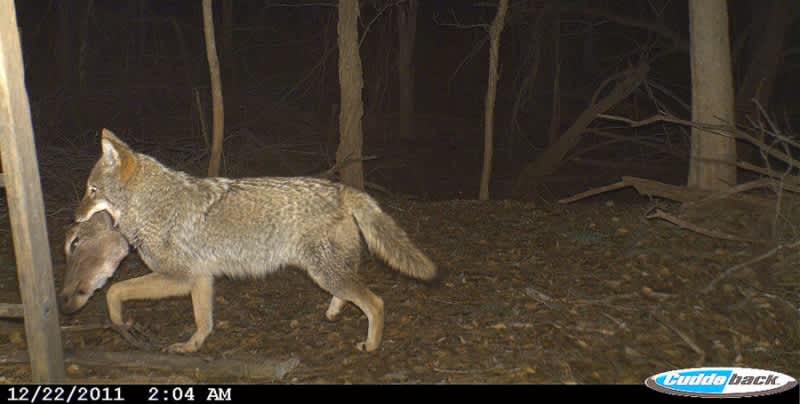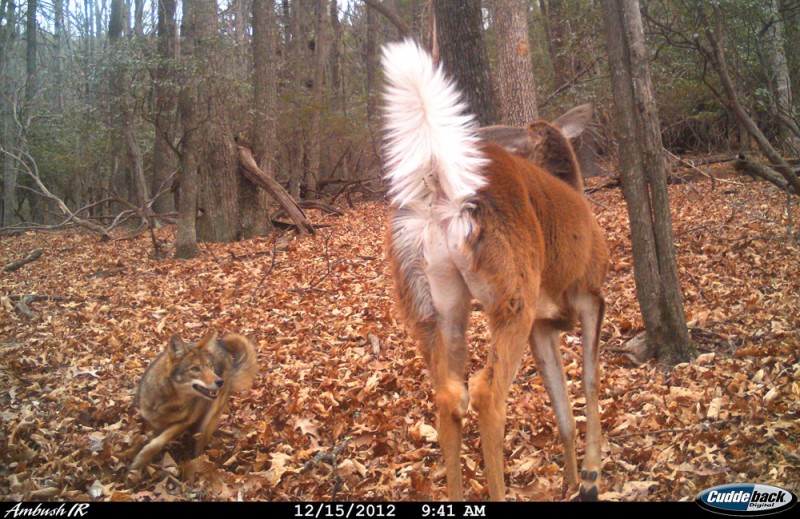Why Such a Fuss Over Coyote Contests?
Patrick Durkin 03.04.16

Since my first outdoors assignment in May 1982, I’ve often been asked to preview upcoming hunting or fishing contests, or to grab a notebook and camera to cover the events for a newspaper’s next edition. I’ve snapped hundreds of “grip-and-grin” photos of happy anglers with winning carp, walleyes, muskies, bluegills, yellow perch, sheepshead, largemouth bass, smallmouth bass, black crappies, white crappies, northern pike and Chinook salmon. For some reason, though, no one holds competitions for inland trout. Trout anglers simply don’t do such things.
Occasionally, I’ve also donated a few dollars to enter big-buck, late-season doe, or longest-beard turkey contests; as well as derbies for squirrels and cotton-tailed rabbits. I’ve even been invited to Western states—but never found the time—for prairie-dog shoots and one-shot antelope contests.
And during a recent weekend in January, I was asked to observe a coyote-hunting contest in Argonne, Wisconsin, but not by its organizers. That wasn’t surprising. Folks who coordinate coyote contests seldom invite media to cover their events. They know predator contests are controversial, even though they differ little from other fishing and hunting contests. They also know some fellow hunters oppose their contests, believing they poorly represent hunting. Still, organizers hold them anyway, and quietly use posters, social media and word-of-mouth to attract contestants.
And although bird-hunters seem as hostile to contests as trout anglers, you’ll find exceptions, like Nebraska’s annual OneBox Pheasant Hunt. Even so, bird hunters mostly hold sporting-dog trials and competitions, and restrict contests to longest pheasant tail-feather or best self-produced grouse-hunting videos.
Back to that coyote contest in Argonne, which is located in the forests of northcentral Wisconsin. My “invitation” came indirectly from folks opposing the contest. They basically requested a reporter to document their protest and provide witness should they be cited for harassing the hunters.
Sheesh. I’m glad I was obligated to photograph a baby shower for one of my daughters that weekend. Who wants to be used by folks just seeking attention? And why don’t animal-rights groups protest other hunting/fishing contests?
Melissa Smith from Friends of the Wisconsin Wolf described the Argonne contest as “senseless bloodlust.” Others said it’s “gratuitous killing,” compared it to cockfighting and dogfighting, and claimed it’s unethical to kill a coyote for prizes or medals.
Hmm. I don’t know. Far more killing occurs in fishing contests, or hunting contests for squirrels, rabbits, deer and turkeys. Or do those events get a pass because we eat or release most fish, and eat everything we shoot except predators? Still, good coyote pelts fetch $30 to $50, and if that’s not enough incentive to skin the carcass, the state has laws prohibiting wanton waste.
Besides, the guys hoisting “big hawgs” in summer bass tournament are likely scoring a “thirty-pointer” in November, weighing a “dry doe” in December, or calling “dogs” in January and February. Are they only “bloodthirsty” and “unethical” when killing coyotes?
Then again, when asked to defend predator contests, the participants’ justifications can sound superficial. Yes, coyotes kill deer, especially newborn fawns in spring, but even the most aggressive trapping and shooting efforts can’t suppress coyote populations unless sustained indefinitely. When coyotes endure heavy losses, they instinctively produce more pups to compensate. And if coyotes are illegitimate killers of “our deer,” why not persecute black bears equally? They, too, target newborn fawns in northern Wisconsin.
If anyone thinks they’re helping deer herds by shooting a dozen coyotes each winter, they probably also think they’re helping walleyes by arrowing boatloads of carp each spring. Both hunts offer great recreation and make some folks feel good, but they’re not ecosystem-management programs.
Likewise, Smith and others claim coyote contests risk gray wolves, because contestants could mistake them for large coyotes. Yes, that’s possible, but let’s face it: Serious, experienced predator hunters are far less likely to accidentally shoot a wolf than are deer hunters or small-game hunters who opportunistically shoot at coyotes each fall.

Besides, when it comes to predator derbies, Wisconsin is the minor leagues. We typically hold a half-dozen such events each winter, and participants are mostly locals who would be hunting anyway, and they typically combine to shoot a dozen or so “dogs” during an event.
In contrast, consider Nebraska, where the 11th annual Coyote Craze Classic in December attracted 40 teams from the home state, as well as Colorado, Wyoming, Kansas, Oklahoma, Nevada, Illinois and South Dakota. The event was based in the Scotts Bluff County Event Center near Mitchell, where teams checked in 173 coyotes while competing for $20,000 in cash and prizes.
And if you want to see coyote hunting’s Major Leagues, consider Frenchville, Pennsylvania, home to the Mosquito Creek Sportsmen’s Association coyote hunt, which attracted nearly 4,000 hunters in February 2015, and a record 5,760 in 2001. Last year’s event offered a purse of $31,824, and hunters weighed in 162 coyotes. One hunter using hounds won $10,990.40, of which $7,808 was for the contest’s largest female coyote (45.05 pounds). That ’yote was also was the third biggest overall, which brought $3,182.40.
That’s cause for indignation in some circles, but let’s concede the outrage is neither universal nor consistently applied.


